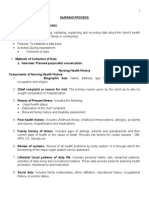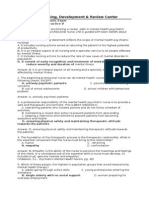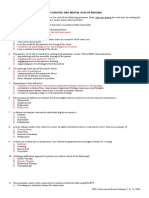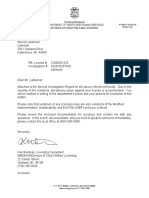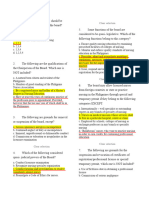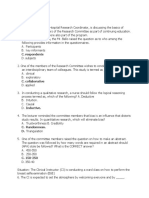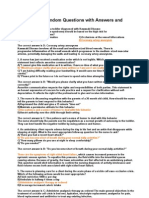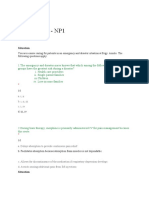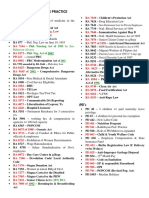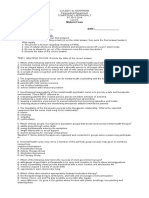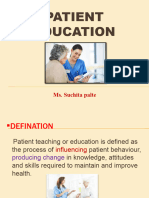Professional Documents
Culture Documents
NP 5
NP 5
Uploaded by
Tudlasan KimmyOriginal Description:
Original Title
Copyright
Available Formats
Share this document
Did you find this document useful?
Is this content inappropriate?
Report this DocumentCopyright:
Available Formats
NP 5
NP 5
Uploaded by
Tudlasan KimmyCopyright:
Available Formats
Nursing Practice V: Care of CLIENTS (Part C)
INSTRUCTION: Select the correct answer for each of the
following questions. Mark only one answer for each item by
shading the box corresponding to the letter of your choice on the
answer sheet provided.
STRICTLY NO ERASURES ALLOWED.
SITUATIONAL
Situation 1:- Sandro 8 years old, 1 grader child has always been
st
the subject of her mother’s prompting and care. He always test
his mom’s rule in preparing for school. Although this has been
for five months now, Sandro still has to be reminded in getting
dress completely and dilly dally eating his breakfast. He still
plays with his toys and interferes with her sister in playing
blocks. The mother is so anxious in reminding Sandro that his
school bus will be arriving in 10 minutes every day.
1. Attention deficit hyperactivity disorder (ADHD) is
characterised by NOT one of the following?
A. Mental Retardation
B. Overactivity
C. Inattentiveness
D. Impulsiveness
2. Which of the following would the nurse expect to see as
symptoms in a child with ADHD?
A. Moody, sullen and pouting behaviour.
B. Interrupts others and cant take turns.
C. Excessive running, climbing and fidgeting
D. Easily distracted, and forgetful
3. Sandro is taking pemoline (Cylert) for ADHD. The nurse
must be aware of which of the following side effects?
A. Decreased thyroid stimulating hormone
B. Decreased red blood cell count
C. Elevated white blood cell count
D. Elevated liver function test results
4. An effective nursing intervention for the impulsive and
aggressive behaviours that accompany conduct disorder is
_______.
A. Open expression of feelings
B. Assertiveness training
C. Negotiation of rules
D. Consistent limit setting
5. Nursing Diagnosis is commonly used when working with
Sandro is _____.
A. Ineffective role performance
B. Impaired social interaction
C. Compromised family coping
D. Risk for injury
Situation 2: - The nurse is teaching a client taking an MAOI
about foods with tyramine that he or she should avoid.
6. Which of the following statements indicates that the client
needs further teaching?
A. “I will have to avoid drinking non alcoholic beer.”
B. “I will be able to eat cottage cheese without worrying.”
C. “I can eat green beans on this diet.”
D. “I’m so glad I can have pizza as long as I don’t order
pepperoni.”
7. Patient’s health teaching for Lamotrigine (Lamictal) should
include which of the following?
A. Take each dose with food to avoid nausea.
B. Eat a balanced diet to avoid weight gain
C. Report any rashes to your doctor immediately
D. This drug may cause psychological dependence.
8. Which of the following health teaching concern for the
nurse as discharged plan for suicidal patient who had been
taking tricyclic antidepressant drugs for 2 weeks and now
ready to go home?
A. The nurse will need to include teaching regarding signs
of neuroleptic malignant syndrome.
B. The patient will need regular laboratory work to monitor
therapeutic drug levels.
C. The nurse will evaluate the risk for suicide by
overdose of tricyclic antidepressant.
D. The patient may need a prescription for Benadryl to use
for side effects.
9. A patient is to take regularly Lithium after discharged. The
MOST important information to impart to the patient and
his family is that the patient should ______.
A. Not eat foods which has high tyramine content like
cheese, wine, liver.
B. Limit his fluid intake
C. Have a limited intake of sodium
D. Have an adequate intake of sodium
10. The patient with diagnosis of Schizhoprenia who has been
taking Clozapine will inform the patient family that the
positive effect of this drug is _____.
A. Monthly liver function studies change moderately
B. Psychotic symptoms such as hearing loss are reduced.
C. Patient develops leukopenia
D. Patients energy level and involvement in activities goes
up
Situation 3: - Patrick, Charge nurse, is aware that the use of
resources are essential for patient care.
11. A safe patient environment includes following factors
EXCEPT:
A. Socio-economic needs
B. Basic needs are met
C. Sanitation is maintained
D. Physical hazards are reduced
12. As an individual, which of the following is an
INTERNAL variable affecting health status, belief, or
practices?
A. Genetics
B. Socioeconomic Status
C. Family structure
D. Living situation
13. Falls are one of the leading environmental hazards
reported in health facilities. One of the most common
occurrences that precipitate a patient fall is ____.
A. Experiencing stress, anxiety and fatigue
B. Leaving the side rails down
C. Reaching item at the bedside
D. Performing activities of daily living
14. In case a patient falls, the nurse’s FIRST responsibility is
to _____.
A. Assess the patient’s injury
B. Write an incident report
C. Report the incident to the head nurse
D. Notify the physician at once.
15. In health care facility, a planned program of loss
prevention and liability control refers to ____.
A. Quality assurance
B. Critical pathways
C. Risk management
D. Peer review
Situation 4: - Mark, a 25 year old student suddenly had
convulsive movements with loss of consciousness during their
lecture. After the episode he was rushed to the nearest hospital.
16. A nurse is conducting physical assessment, which of the
following is INAPPROPRIATE action at this stage?
A. Insert intravenous cannula
B. Assess patient’s lifestyle
C. Assess patient source of stress and coping habits
D. Identify the patient’s daily activity
17. Mark is scheduled for an EEG after having a seizure for
the first time. What is the BEST patient preparation
instruction before the procedure?
A. “Avoid thinking and personal matters for 12 hours
before the test.”
B. “Do not shampoo your hair for 24 hours before the test.”
C. “Do not eat anything for 12 hours before the test.”
D. “Avoid stimulants and alcohol for 24 to 48 hours
before the test.
18. Which of the following manifestations should the nurse
APPROPRIATELY observe during generalized seizures?
A. Loss of consciousness, dilated pupils, and muscular
stiffening.
B. Jerking movements of all extremities.
C. Facial grimace with patting and smacking
D. Vacant stare with a brief loss of consciousness.
19. What is the FIRST priority which the nurse must observe
in caring for patient with seizure?
A. Safety
B. Airway
C. Nutrition
D. Mobility
20. Phenytoin (Dilantin) has been prescribed for a patient.
Based on an understanding of the medicine, what is the
APPROPRIATE nursing instruction of the nurse?
A. Give Dilantin intramuscularly
B. Administer good oral hygiene
C. Dilute IV Dilantin with 5% dextrose
D. Maintain a Dilantin level of 30-50 microgram/ml
Situation 5: Gloria is a nurse researcher in the Department of
Health. She is assigned to conduct research on patient’s safety
practices of nurses in the psychiatric unit. She is given 6 months
to conduct the study.
21. After formulating and delimiting the research problem,
which of the following will be a PRIORITY action of
Gloria?
A. Develop the theoretical framework of the study.
B. Formulate the hypothesis
C. Plan the research design of the study.
D. Conduct a literature search on the topic
22. Gloria decides to include only nurses who have a
minimum three years experience as psychiatric nurses.
Which of the following terms refer to this?
A. Concept
B. Variable
C. Limitation
D. Delimitation
23. The statement “The length of service is not associated
with the degree of patient safety practices of staff nurses” is
an example of a/an _____.
A. Variable
B. Assumption
C. Hypothesis
D. Theory
24. Which of the following research designs is MOST
APPROPRIATE for this study if the aim is to find a
relationship between two variables in the study?
A. Phenomenological study
B. Experimental study
C. Exploratory
D. Correlational
25. She plans to interview the Psych Nurse Manager about the
patient safety practices of the nurses. What type of
sampling includes those who happens to be in the
conference room where the activity is scheduled?
A. Random
B. Purposive
C. Convenience
D. Quota
Situation 6: - Belle is a 30 year old single mother who is
dependent on her family for support. Her diagnosis is mild
mental retardation with Post traumatic disorder with depressive
episodes related to her mother’s death. Her current symptoms
include depressed mood with irritability, difficulty tolerating
frustation, difficulty falling asleep, increased appetite and
weight gain, hypervigilance and worry that something terrible
will happen to her child.
26. A cognitive assessment of Belle indicated that according
to Piaget’s theory she was functioning at the concrete
operational stage. Which of these behaviours would the
nurse observe in Belle?
A. Thinks logically and sees possibilities
B. Understands only her own viewpoint
C. Feels her own reasoning should agree with the reasoning
of others.
D. Makes and tests hypothesis.
27. Belle has difficulty tolerating frustation. The GOAL of the
nurse is to assist Belle to ___.
A. Increase her self esteem
B. Cope with anxiety
C. Recognize her needs
D. Mobilize her resources
28. Which of the following historical data MOST probably
led to a post traumatic stress disorder?
A. Unstable relationship with ex-fiance
B. Suicide of her mother
C. No gang relationship with peers
D. Dropping out of school
29. Given her problems of hypervigilance and worry that
something terrible will happen to her child, nursing
interventions should be aimed at addressing her needs for
______.
A. Love and belongingness
B. Biological integrity
C. Psychological security
D. Self-esteem
30. In terms of social support therapy, which of these is the
MOST APPROPRIATE and therapeutic?
A. With Appropriate support, lives in the community,
either independently or in supervised setting.
B. Individualized relationship with a caregiver
C. High structured environment with constant aid and
supervision
D. Vocational training with moderate supervision but not
beyond second grade academic challenges.
Situation 7: The following scenario are potential routines that
could check work ethics of a professional nurse.
31. A patient asks to be discharged from the health care
facility against medical advice (AMA). What should the
nurse do?
A. Notify the physician
B. Prevent the patient from leaving
C. Have the patient sign an AMA form
D. Call a security guard to help detain the patient.
32. A nursing asssistant is assigned to provide morning care to
patient. How should the nurse document care given by the
nursing attendant?
a. “Morning care rendered.”
b. “Morning care rendered by Grace Go, NA.”
c. “Morning care provided by G.G., Nursing assistant.”
d. “Morning care refused to be given by the nursing
assistant.”
33. A nurse administers the wrong intravenous fluid to a
patient. She should accomplish which of the following
documents to be submitted to her immediate supervisor?
A. Patient Kardex
B. Incident Report
C. Progress Report
D. Endorsement record
34. When developing a care plan for a patient with a do-not-
resuscitate order, the nurse should NOT include which
intervention on the care plan?
A. Allow access to individuals who can provide spiritual
care.
B. Administer pain medications as ordered by the
physician.
C. Provide usual routine nursing care as ordered by the
physician.
D. Administer lethal doses of medication as patient
request.
35. A patient is to undergo a laminectomy in the morning. The
physician asks the nurse to witness the patient’s signing of
the consent form. What is the BEST action of the nurse?
A. Provide emotional support for the patient while the
patient signs the consent.
B. Make sure the physician explains the risks of undergoing
the procedure.
C. Make sure the physician thoroughly describes the
procedure.
D. Make sure the patient is competent, awake and alert
before he/she signs the consent form.
Situation 8: - Charge Nurse Tessie works at the surgical ward.
She ensures good record management is implemented in her unit
at all times.
36. A patient is having elective surgery under general
anesthesia. Who is responsible for obtaining the informed
consent?
A.. Surgeon
B. Nurse
C. Nurse Anesthetist
D. Anesthesiologist
37. Which statement by the patient indicates that he
understands the explanation of the surgeon?
A. “I refuse to sign the consent form; another family
member can sign. For me.”
B. “Now I know what the alternative treatments and
procedures are.”
C. “If I refuse. To sign the consent form, other treatment
will be withdrawn.”
D. “If I can’t refuse the procedure after the consent is
signed.”
38. The unit secretary who transcribes the physicians order
asks the nurse to interpret an order because she cannot read
the writing. The nurse’s BEST action is to ____.
A. Clarify the order with the pharmacies
B. Clarify the order by calling the physician
C. Interpret the order according to the patient’s previous
medication record.
D. Clarify the order with junior staff.
39. The physician orders to transfuse 500 ml packed RBC
blood postoperatively. The nurse must check the name on
the label of the blood with the name on the patient’s _____.
A. Medication administration record
B. Wristband in the presence of another nurse
C. Medical chart
D. Wristband
40. The patient’s wife is so anxious about the condition of her
husband. The MOST appropriate INITIAL intervention for
the nurse to make is to _____.
A. Describe her husband’s medical treatment since
admission.
B. Reassure her that the important fact is her presence
C. Explain the nature of the injury and reassure her that
husband’s condition is stable.
D. Allow her to verbalise her feelings and concerns.
Situation 9:- Quality and Safety are rooted in the daily work of a
healthcare professional. Nurses in the Orthopaedic Unit attends
monthly quality assurance meeting. The following questions
were discussed.
41. Who should be involved in quality improvement
measures?
A. Everyone
B. Management staff
C. Professional staff
D. Consumers
42. To start a nursing improvement project, what is the FIRST
step that a nurse must keep in mind?
A. Implement plan to correct the problem.
B. Determine the nursing standards.
C. Determine findings if warrant correction
D. Collect data, determine if standards are met.
43. To achieve organised work flow in the unit, the staff must
be aware of the head nurse’s role. What is the PRIMARY
purpose of supervision and delegation?
A. Enhances the delivery of quality nursing care.
B. Influences organisation’s approach in personnel
evaluation
C. Improves staff attendance in seminars
D. Assigns any staff to do the tasks or project.
44. To ensure quality nursing care to a patient in skin traction,
what is the PRIORITY intervention that a nurse has to
assess frequently?
A. Signs of infection around the pin site.
B. Signs of skin breakdown
C. Urinary incontinence
D. Presence of bowel sounds
45. The nursing team plans to do chart audit project on post-
op patients who had developed pressure sores at the
Orthopedic unit over the past year to present. What type of
audit is?
A. Retrospective
B. Process
C. Concurrent
D. Outcome
Situation 10: - Incidence of drug abuse has greatly increased
overtime. Korino has been using drugs for the past three years.
46. You are a Drug Abuse Treatment and Rehabilitation
Center Nurse. During the assessment of a newly admitted
Person Who Uses Drugs (PWUDs) named Korino, which
of the following is the MOST APPROPRIATE question to
ask?
A. Ask Korino how long he thought that he could take
drugs without someone finding it.
B. Ask Korino why he started taking illegal drugs.
C. Not ask any questions for fear Korino will deny and may
become assaultive
D. Ask Korino about the amount of drug used and its
effect and how long he had been using.
47. Upon data collection he had been failing three times in his
math class and Korino was known for substance dependent
for three years. What is the MOST APPROPRIATE nursing
diagnosis for him?
A. Alteration in perception
B. Alteration in social interaction
C. Ineffective individual coping
D. Impaired judgement
48. Korino has been using meperidine and codeine for
personal consumption. Which of the following does the
nurse understand as the physiologic effect of these drugs?
A. Increases sexual stimulation
B. Relieves pain by increasing pain threshold
C. Decrease craving for alcoholic intake
D. Heightens concentration and alertness
49. Which assessment by the nurse would cause a concern for
Meperidine overdose?
A. Respiration rate of 12 bpm
B. Hypercapnia
C. Dryness of the skin
D. Pinpoint pupils
50. What drug should the nurse prepare for administration to
reverse all signs of toxicity?
A. Digibind (Digoxin)
B. Naloxone (Narcan)
C. Atropine Sulfate
D. Diazepam (Valium)
Situation 11: Effective communication is a core skill for nurses
that a professional nurse must apply in their daily routine for
patient care, colleagues and family.
51. The nurse asks the patient,. “What do you fear MOST
about your surgery tomorrow? This is an example of which
communication technique?
A. Providing general leads.
B. Summarizing
C. Seeking Clarification
D. Presenting Reality
52. The patient made the following statement to the nurse,
“My Doctor just told me that he cannot save my leg and
that I have an above the knee amputation.” Which response
by the nurse is MOST APPROPRIATE?
A. “TELL me more.”
B. “Dr. Benito is an excellent surgeon.”
C. “If I were you, I will get a second opinion.”
D. “Are you in pain?”
53. A nurse is communicating with attending physician about
medical intervention prescribed for a patient post spine
surgery. Which statement is INDICATIVE of a
collaborative relationship?
A. “Can we talk about Mrs. Santos?”
B. “I am worried about Mrs. Santos blood pressure. It is
not decreasing even with the new antihypertensive
medication.”
C. “That new medication you prescribed for Mrs Santos is
ineffective.”
D. “We do not need to talk about Mrs. Santos’ blood
pressure.
54. An 80 year old male, admitted for emergency suturing of
the forehead sustained from accident fall while gardening
under local sedation. He was just received in the ward.
Which nursing intervention is APPROPRIATE to facilitate
effective communication with this patient?
A. Talk to patient when fully awake and inform him and
family events which may occur post-surgery.
B. Provide the patient with instructional materials about
discharge.
C. Tell the patient, “You are fine nothing to worry.”
D. Ask the patient, “do you know where you are?”
55. The nurse who uses appropriate therapeutic listening skills
will display which BEST behavior?
A. Presume an understanding of the patient needs.
B. React quickly to the message.
C. Reassure the patient that everything will be fine.
D. Absorb both the content and the feeling which
patient is conveying.
Situation 12: - Effective teamwork and collaboration in nursing
is achieved when individuals work together in harmony,
processes and goals are aligned towards achieving safe quality
patient care.
56. Which of the following actions is INAPPROPRIATE for a
nurse leader to apply in a work setting?
A. Ask staff member if their opinion on the matter.
B. Modifies his own behaviour favoring the needs of
individual staff.
C. Gives equal considerations to each staff member.
D. Plans and organises group activities of staff member.
57. In problem solving, the head nurse must know what is the
MAJOR characteristic of negotiation?
A. Be positive in your approach since optimism goes
further favorable results.
B. Harmony is possible even when strategies are not well
planned.
C. It is not important to get anything in writing since the
truth will prevail.
D. Resources tend to involve too many individuals in
decision making process.
58. Applying multidisciplinary approach of patient care,
which among the members of the multidisciplinary team
that the nurse would MOST likely collaborate with when
the patient is at risk of fall due to an impaired gait?
A. Podiatrist
B. Physical therapist
C. Speech therapist
D. Nutritionist
59. The nurse manager has implemented a change in the
method of the nursing delivery system from functional to
team nursing. A nurse is resistant to the change and is not
taking an active part in facilitating the process of change.
Which is the BEST approach in dealing with the nurse?
A. Exert coercion on the nurse.
B. Provide a positive reward system for the nurse.
C. Talk and encourage verbalizing feelings of the
change.
D. Ignore the resistance of the nurse.
60. Which among the members of the multidisciplinary team
that the nurse would be BEST to collaborate with when the
patient can benefit the use of leg prosthesis?
A. Occupational therapist
B. Physical Therapist
C. Podiatrist
D. Pharmacist
Situation 13: - Karen is seventeen years old, grade twelve, active
in gymnastics. She is five feet and seven inches tall, weighs
eighty five pounds. Her family doctor diagnosed her with
anorexia nervosa.
61. Which of the following statements should Nurse Cora
consider as TRUE with anorexia nervosa?
A. Thinness is equated with vanity among peers.
B. Eating disorders are not major health problems.
C. Cultures linking beauty to thinness increase risk of
illness.
D. Anorexia nervosa is not considered as a mental disorder.
62. Karen is being assessed for eating disorder. Which option
is suggestive of anorexia nervosa?
A. Lack of knowledge about food and nutrition
B. Guilt and shame about eating disorders.
C. Refusal to talk about food related topics
D. Unrealistic perception of body size.
63. Nurse Cora is working with Karen. Even though Karen
has been eating all her meals and snacks, her weight has
remained unchanged for a week. Which nursing
interventions is APPROPRIATE for Karen?
A. Supervise Karen closely for 2 hours after meals and
snacks
B. Supervise Karen closely 2 hours before and after meals
C. Increase the daily caloric intake from 1500 to 2000
calories
D. Increase the daily caloric intake from 1800 to 3000
calories.
64. One morning, as Nurse Cora entered Karen’s room, she
noticed that the patient was engaging in a rigorous push
ups. Which nursing action is MOST APPROPRIATE?
A. Allow her to complete her exercise program.
B. Tell her that she is not allowed to exercise rigorously
C. Interrupt her and offer to take her for a walk.
D. Interrupt her and explain that exercise is not needed.
65. Which of the following is the INITIAL goal for treating
the severely malnourished patient with anorexia nervosa?
A. Nutritional rehabilitation
B. Correction of body image disturbance
C. Weight restoration
D. Correction of electrolyte imbalances
Situation 14: - Annie is a 38 year old woman with three
children. She has a history of otosclerosis. She is admitted for
ear surgery.
66. While taking nursing history on Annie, What will be the
response of the patient that indicates her present condition?
A. She frequently experience vertigo, nausea and
nystagmus when sitting.
B. She has ear pain and discharge from the left ear when
travelling.
C. She has had impaired hearing since birth
D. Her hearing loss has become worse with each
succeeding pregnancy.
67. Annie states, “I’m afraid to let my children out of my
sight now that I can’t hear them.” What is the nurse’s best
response?
A. “Tell me about your fears of losing contract with
your children now that you can’t hear them.”
B. “Children need some freedom, and the mother has to
learn to trust them.”
C. “Do the children usually misbehave when they cannot be
seen or heard by you?”
D. “what can the children do to make you feel more
comfortable?”
68. What should be APPROPRIATE in the nursing care plan
for Annie having otosclerosis?
A. Substitute meaningful sensory input by the use of
other senses.
B. Orient Annie to the staff, the unit, and all treatments.
C. Give nursing care that will meet her psychological
needs.
D. Make frequent calls to prevent isolation and loneliness.
69. The day after surgery, Annie expresses concern that
hearing is not as good as it was before admission. What is
the BEST nurse action?
A. Encourage Annie to divert her attention by reading.
B. Encourage Annie to blow more her nose to clear the
eustachian tube.
C. Reassure Annie that it is temporary loss due to post-
op edema and ear packing.
D. Check the external ear for blood clots and remove them.
70. What post-operative teaching will the patient STRICTLY
follow?
A. Reinforce that fact that airplane travel is no longer
permitted.
B. Show patient how to gently irrigate the external auditory
canal.
C. Inform physician any dizziness that develops after
she is discharged.
D. Stress that hair washing should be avoided immediately
after surgery.
Situation 15: - Sandy, a 58 year old teacher had a left total hip
replacement due to Osteoarthritis.
71. Sandy should be placed in which of these position for
meals?
A. Supine
B. Trendelenburg’s
C. Semi-Fowlers
D. Sim’s Lateral
72. The nurse did preoperative teaching to Sandy who’s
admitted for hip replacement surgery. Which statement of
Sandy indicates the need for further preoperative teaching?
A. I’ll rest in bed for 2 to 3 hours after surgery.
B. I’ll begin gait training within 48 hours
C. “I should do muscle strengthening exercises in both
legs.
D. “ I need to turn, cough and breath deeply every 2 hours.”
73. The physical therapist orders exercises of Sandy’s left hip,
knee, and foot to gradually increase range of motion to the
left hip. The nurse can BEST assist Sandy by _____.
A. Observing Sandy’s ability to perform the exercises.
B. Performing the exercises for Sandy
C. Administering an analgesic before the exercises
D. Stopping the exercise if Sandy experiences pain.
74. Sandy should be instructed to avoid ______.
A. Assuming prone position
B. Abducting her left leg.
C. Putting any weight on her left leg.
D. Adducting her left leg
75. Sandy asks the nurse if her new joint will function
normally. The Nurse can BEST answer this by saying that
the _____.
A. Doctor will be able to assess your limitations in 6
weeks and then explain them to you.
B. New joint will function almost as well as a normal joint,
if you perform your exercises faithfully.
C. New joint will be stronger than the old one if you
exercise well.
D. New joint won’t function as well as the new joint, but
will be better than the arthritic joint.
Situation 16: - When nurses are considering issues on control,
shame and stigma, surrounding the subject of mental illness, one
of the primary considerations should be nurse’s own sensitivity
in recognizing signs of mental health problem. Ethics pervades
good practice. The following situations apply.
76. A patient is brought to the hospital by his officemates
because he kept on blaming his immediate supervisor of
getting him fired from his job. Ethical problems may arise
when diagnosing psychiatric patients because of _____.
A. Inadequate staffing
B. Lack of exercise
C. Subjectivity
D. Inappropriate diagnostic procedure
77. The nurse is administering psychotropic medication to the
patient. The patient refused to take the medication. Which
of the following situations would guide the nurse where a
patient refuses medications?
A. Cannot refuse his medication regardless of his medical
diagnosis.
B. Need a court order to allow the patient to refuse his
medication.
C. Can refuse this medication if he has not been deemed
incompetent by formal legal procedure.
D. May refuse the medications only if his attending
physician agrees.
78. Which of the following is a basic safeguard to ethical
practice by the nurse is providing care to patients with
borderline personality disorders who are extremely
provocative and manipulative?
A. Observing human to human relationship
B. Seeking clinical expert opinion
C. Practicing self-awareness constantly
D. Applying person centered approach
79. The patient verbalizes to the nurse about thought of
“threatening to kill his wife.” The nurse is in dilemma
whether to tell the wife about this conversation. Given this
situation which of the following is the appropriate action of
the nurse?
A. Alert immediately the proper authorities regarding
the threat to safeguard the safety of the wife.
B. Tell the wife to be very extra careful as her life is in
danger.
C. Weigh carefully the situation by viewing it as dilemma
between disclosing confidential information or warning
appropriate authorities.
D. Keep the information to herself and be vigilant on the
action of the patient to protect the wife.
80. The psychiatric diagnosing of patients is a morally
charged issue and the assigning of diagnosis may be an
ethical issue. The role of the nurse in diagnosing
psychiatric patient is important because nurses are ____.
A. Collaboration in the diagnostic process.
B. Planners of psychiatric nursing care.
C. Knowledgeable in the field of psychiatry due to
extensive clinical experience.
D. Competent by virtue of their educational preparation.
Situation 17: - Mrs Juan, a young female patient, believes that
doorknobs are contaminated with COVID-19 and refuses to
touch them except with the aid of tissue paper.
81. Her diagnosis of obsessive compulsive disorder constantly
does repetitive cleaning. The nurse knows that this
behavior is probably MOST basically an attempt to ____.
A. Decrease the anxiety to a tolerable level.
B. Focus attention on non threatening tasks.
C. Control others
D. Decrease time available for interaction with people.
82. What response should the nurse use in dealing with this
behavior?
A. Encourage her to scrub the doorknobs with a strong
antiseptics so she does not need to use tissue papers.
B. Supply her with paper tissue to help her function
until her anxiety is reduced.
C. Force her to touch doorknobs by removing all available
paper tissue until she learns to deal with the situation.
D. Explain to her that ideas about doorknobs with covid-19
is part of her illness and is not necessary.
83. Signs such as using tissues to doorknobs develop because
the patient is _____.
A. Unconsciously controlling unacceptable impulses or
feelings.
B. Listening to voices that tell her that doorknobs are
unclean.
C. Consciously using this method of punishing himself.
D. Fulfilling a need to punish others by carrying out
annoying procedure.
84. Therapeutic treatment for MRs. Juan should be directed
towards helping her to _____.
A. Learn that her behavior is not serving a realistic purpose.
B. Forget her fears by administering antianxiety
medications.
C. Redirect her energy into activities to help others.
D. Understand her behavior is caused by unconscious
impulses that she fears.
85. The nurse plans to educate the entire family about
obsessive compulsive disorder. Which of the following
plans would be MOST effective?
A. The nurse directs Mrs. Juan and her family to the other
resources to help them learn about the illness and
medication to treat it.
B. The nurse teaches the family about Mrs. Juan’s illness
and medication and suggest that they educate Mrs. Juan
about her disease and the medications to treat it.
C. The nurse educates the entire family at the same time
about the disease and medications to treat it.
D. The nurse teaches Mrs. Juan about her illness and her
medications and suggests that she teaches her family
what she has learned.
Situation 18: - Latest death toll in the Philippines due to Corona
virus after Easter 2021 was 13,425. It was so scary that within a
year this COVID-19 virus takes its toll. The nurse must
understand the importance of self-awareness and competencies
in helping patients and families during bereavement.
86. When human needs are taken away or not met for some
reason, a person experiences loss. Using Maslow’s
hierarchy of needs, which one of the following will the
nurse consider a loss in case of death?
A. Loss of security and a sense of belonginess.
B. Loss related to self actualization
C. Physiologic and safety loss
D. Loss of self-esteem
87. Vangie, 73 years old, comorbid with hypertension and
asthma died of COVID. Ariel grieved and mourned to the
loss of his mother’s untimely death. He is now aware that
his mother is one of those 13,425 deaths. The nurse will
consider at what stage of grieving process is Ariel
experiencing?
A. Depression
B. Bargaining
C. Denial and Anger
D. Acceptance
88. Which of the following gives cues to the nurse that the
patient may be grieving for a loss?
A. Thoughts, feelings, behavior, and physiologic
complaints.
B. Hallucination, panic level of anxiety, sense of impending
doom.
C. Sad affect, anger, anxiety and sudden change of mood
D. Complaints of abdominal pain, diarrhea, loss of appetite
89. Which of the following situations will the nurse consider
as risk factors for complicated grief?
A. Childbirth, marriage and divorce.
B. Death of a spouse, child, and death by suicide.
C. Inadequate perception of the grieving process.
D. Inadequate support and old age
90. As a nurse, which of the following are the critical factors
for successful integration of loss during the grieving
process?
A. The patient’s predictable and steady movement from one
stage of the process to the next.
B. Accurate assessment and intervention by the nurse
or helping person
C. The nurse trustworthiness and healthy attitude about
grief.
D. The patient’s adequate perception, adequate support, and
adequate coping.
Situation 19: - Ms. Diaz, a new charge nurse of EENT unit is
keen on staff and professional growth of the nursing team.
91. Ms. Diaz learns that some leaders are transactional
leaders. Which of the following does NOT characterise a
transactional leader?
A. Focuses on management tasks
B. Inspires others with vision
C. Is a caretaker
D. Uses bargaining to meet goals.
92. Ms. Diaz finds out that some managers have benevolent-
authoritative style of management. Which of the following
behaviors will she exhibit MOST likely?
A. Have condescending trust and confidence in their
subordinates.
B. Gives economic or ego awards.
C. Communicates downward to the staff.
D. Allows decision making among subordinates.
93. Ms. Diaz knows that there are external forces that
influence changes in his unit. Which of the following is
NOT an external force?
A. Demands of the labor sector to increase wages.
B. Exacting regulatory and accreditation standards.
C. Low Morale of staff in his unit
D. Memo from the CEO to cut down on electrical
consumption
94. After discussing the possible effects of the low patient
satisfaction rate, the staff started to list down possible
strategies to solve the problems head-on. Should they
decide to vote on the best change strategy, which of the
following strategies is referred to this?
A. Majority rule
B. Dominance
C. Collaboration
D. Compromise
95. The nurse asks the aide to weight the patient. Later, the
nurse discovered that a patient has been weighed who is
supposed to be on complete bed rest. This situation violates
which of the following rights of delegation?
A. Right person
B. Right direction and communication
C. Right supervision and evaluation
D. Right task
Situation 20: - Peter, a 19 year old college student, has been in
excellent health until developing a flu-like illness couple of
weeks ago. He is admitted with diagnosis of Guillain-Barre
Syndrome.
96. Which of the following clinical manifestations would the
nurse expect to find when performing admission
assessment?
A. Rapid progressive muscular atrophy
B. Ascending paralysis with ataxia
C. Hyperactive deep tendon reflexes
D. Paresthesia and muscle weakness of upper body
97. What is the MOST APPROPRIATE nursing diagnosis for
this patient?
A. Self care deficit related to neuromuscular impairment.
B. Alteration in nutritional status related to possible
choking
C. Alteration in nutritional status related to anorexia
D. Alteration in urinary elimination related to sensory
motor impairment.
98. What is the PRIORITY of care for patient diagnosed with
Guillan Barren Syndrome?
A. Maintenance of respiratory function
B. Control of urinary tract infection
C. Prevention of decubitus
D. Replacement of fluid and electrolytes
99. In planning the nursing care for this patient, What is the
MOST important nursing intervention a nurse must do?
A. Encourage patient to release anxiety by crying.
B. Reassure family that complete recovery is probable.
C. Assess patient for respiratory distress.
D. Have patient assist with care.
100. What symptom is an INDICATOR of cranial nerve
involvement?
A. Difficulty of speaking and chewing
B. Spastic paralysis of the extremities
C. Loss of pain sensation
D. Forgetfulness and syncope
——END—-
You might also like
- NP3Document12 pagesNP3Lyca Berin100% (1)
- NP1 CHN 2018 PDFDocument86 pagesNP1 CHN 2018 PDFJOHN CARLO APATANNo ratings yet
- Community Health Nursing (Pre-Test) : B. Fertilized Ascaris Lumbricoides OvaDocument2 pagesCommunity Health Nursing (Pre-Test) : B. Fertilized Ascaris Lumbricoides OvaSolsona Natl HS Maananteng100% (2)
- PHC Exam Revision Questions Test A v2Document18 pagesPHC Exam Revision Questions Test A v2Anonymous TZQNraBL100% (13)
- NP IiDocument11 pagesNP IiOlivia LowellNo ratings yet
- Nursing Health HistoryDocument11 pagesNursing Health Historyrubycorazon_edizaNo ratings yet
- Nursing Test 1 (NP III)Document10 pagesNursing Test 1 (NP III)Paul Nathan Betita100% (2)
- NP5 SET A With AnswersDocument13 pagesNP5 SET A With AnswersMiss G75% (4)
- NP 4 - TraDocument28 pagesNP 4 - Tranella rapanutNo ratings yet
- 61e1a14b1ceb4 PB3-NP5-STUDENTDocument9 pages61e1a14b1ceb4 PB3-NP5-STUDENTKevin PatrickNo ratings yet
- NP1 1Document13 pagesNP1 1Lyca Berin100% (1)
- NP2 1 1Document12 pagesNP2 1 1Lyca Berin100% (1)
- Ratio R2 NP 1Document16 pagesRatio R2 NP 1Konstantin Konstantius100% (4)
- Medical Surgical 1: Johdel CabalunaDocument235 pagesMedical Surgical 1: Johdel CabalunaAlthea Marie C. Mado100% (4)
- NP 5Document14 pagesNP 5Yaj Cruzada100% (1)
- Nursing Practice VDocument9 pagesNursing Practice VLloyd Rafael Estabillo100% (1)
- Imbalance Nutrition Less Than Body Requirements Related To Loss of Appetite Due To Aging.Document1 pageImbalance Nutrition Less Than Body Requirements Related To Loss of Appetite Due To Aging.Senyorita KHaye78% (9)
- Recalls 1 Exam Nursing Practice 1: Name: Date: SCOREDocument7 pagesRecalls 1 Exam Nursing Practice 1: Name: Date: SCOREWILMAR DEL MONTE50% (2)
- NP5 Nursing Board Exam December 2006 Answer Key 'Nursing Care of Client With Physiological and Psychosocial Alteration'Document13 pagesNP5 Nursing Board Exam December 2006 Answer Key 'Nursing Care of Client With Physiological and Psychosocial Alteration'Marjorie RefuerzoNo ratings yet
- Give Away CBQDocument26 pagesGive Away CBQGreggy Francisco Lara100% (4)
- Upang Nursing PsychDocument8 pagesUpang Nursing PsychRamon Carlo Almiranez100% (4)
- Set v. Care of Clients With Physiologic and Psychosocial Alterations C (Answers)Document11 pagesSet v. Care of Clients With Physiologic and Psychosocial Alterations C (Answers)Yaj CruzadaNo ratings yet
- Psychiatric and Mental Health Nursing Answer KeyDocument10 pagesPsychiatric and Mental Health Nursing Answer Keyjeshema90% (20)
- Tacloban City HospitalDocument20 pagesTacloban City HospitalReah Jayzel AlkuinoNo ratings yet
- Ambulatory Surgical CareDocument265 pagesAmbulatory Surgical CareThamizhanban R100% (2)
- Community Family AssessmentDocument6 pagesCommunity Family AssessmentFely Theresa Lanes LorenoNo ratings yet
- Investigative Report On Student Death at Lakeside AcademyDocument63 pagesInvestigative Report On Student Death at Lakeside AcademyWWMT100% (2)
- Nursing Test 1 (NP V)Document9 pagesNursing Test 1 (NP V)Paul Nathan BetitaNo ratings yet
- NP IiiDocument13 pagesNP IiiVia LatrasNo ratings yet
- PROF AD POST TEST AnswersDocument14 pagesPROF AD POST TEST AnswersRika MaeNo ratings yet
- Nursing Test 5 (NP Iii)Document12 pagesNursing Test 5 (NP Iii)Yuxin LiuNo ratings yet
- Palmer Q - ADocument20 pagesPalmer Q - AYuxin LiuNo ratings yet
- Pedia EnhancementDocument28 pagesPedia EnhancementJan Crizza Dale R. FrancoNo ratings yet
- NP 3 - TraDocument31 pagesNP 3 - Tranella rapanutNo ratings yet
- Recalls 1 - Np4Document37 pagesRecalls 1 - Np4ChiiiiNo ratings yet
- Ob FCDocument313 pagesOb FCJames Eugene CaasiNo ratings yet
- np1 Answer and RationaleDocument17 pagesnp1 Answer and RationaleGrace Mellaine100% (1)
- Nursing Test 1 (NP Iv)Document10 pagesNursing Test 1 (NP Iv)Yuxin Liu100% (1)
- PALMDocument21 pagesPALMGiovanni Enrile100% (1)
- 75 Items MS Random Questions With Answers and Rationale NLEDocument12 pages75 Items MS Random Questions With Answers and Rationale NLEAr-jay Jubane100% (7)
- Recalls 2 - Np3Document37 pagesRecalls 2 - Np3ChiiiiNo ratings yet
- Recalls 3Document180 pagesRecalls 3feonna acostaNo ratings yet
- Endo WorkbookDocument15 pagesEndo Workbookceline del pilarNo ratings yet
- Funda PosttestDocument11 pagesFunda PosttestRhea May Capor0% (1)
- NLE Pre Board JUNE 2008 NPT 3-QUESTIONS AND RATIONALEDocument20 pagesNLE Pre Board JUNE 2008 NPT 3-QUESTIONS AND RATIONALEKeish ShuneNo ratings yet
- CDC 2Document39 pagesCDC 2Erica May Formacion SeverinoNo ratings yet
- Pamantasan NG Cabuyao Banay-Banay, Cabuyao City, Laguna Bachelor of Science in Nursing Diagnostic Examination Iii-ADocument19 pagesPamantasan NG Cabuyao Banay-Banay, Cabuyao City, Laguna Bachelor of Science in Nursing Diagnostic Examination Iii-Aissaiahnicolle100% (2)
- Posttest GeriaDocument7 pagesPosttest GeriaJohn Lyndon SayongNo ratings yet
- Mental Health Disorders Nclex Nursing ResourcesDocument79 pagesMental Health Disorders Nclex Nursing ResourcesSadako100% (1)
- NP4 Recalls7Document11 pagesNP4 Recalls7AhrisJeannine EscuadroNo ratings yet
- NP 5Document26 pagesNP 5Allaiza CristilleNo ratings yet
- NP2 Pre Board Practice TestDocument12 pagesNP2 Pre Board Practice TestErickaNo ratings yet
- Post Test Palmer 4 FinalDocument11 pagesPost Test Palmer 4 FinalCharmaine Rose Inandan Triviño100% (1)
- Nursing Practice 4 (Dec 2006)Document11 pagesNursing Practice 4 (Dec 2006)ɹǝʍdןnosNo ratings yet
- Part 2 PNLE MAY 2022 PSYCH PABAONDocument9 pagesPart 2 PNLE MAY 2022 PSYCH PABAONJustine Cagatan100% (1)
- NLE NP1 QuestionsDocument38 pagesNLE NP1 QuestionsLouie John AbilaNo ratings yet
- Nursing Test 3 (Np-I)Document20 pagesNursing Test 3 (Np-I)Yuxin LiuNo ratings yet
- Nursing Test 4 (NP Iv)Document9 pagesNursing Test 4 (NP Iv)Yuxin LiuNo ratings yet
- Nursing LawsDocument2 pagesNursing LawsYuxin Liu100% (1)
- NP4 Nursing Board ExamDocument7 pagesNP4 Nursing Board ExamNewb TobikkoNo ratings yet
- Nursing Test 3 (NP Iii)Document17 pagesNursing Test 3 (NP Iii)Yuxin LiuNo ratings yet
- Nursing Practice Test Community Health Nursing and Care of The MoDocument8 pagesNursing Practice Test Community Health Nursing and Care of The MoElaine BriososNo ratings yet
- NP 1Document28 pagesNP 1nella rapanut100% (2)
- Prof Ad With AnswersDocument8 pagesProf Ad With AnswersYuxin LiuNo ratings yet
- Nle Nursing Practice VDocument13 pagesNle Nursing Practice Vjptorresrn09No ratings yet
- Ca 2Document10 pagesCa 2sophi30100% (1)
- Dec06np5 Nursing Care of Client With PhysiologicalDocument11 pagesDec06np5 Nursing Care of Client With PhysiologicaljavadahuttNo ratings yet
- NP5 .Nursing Board Exam June 2008 Answer KeyDocument33 pagesNP5 .Nursing Board Exam June 2008 Answer KeyAlyssa Mier Dacua Patalinjug100% (1)
- 2022 Year in Review - PowerPoint - January192022Document81 pages2022 Year in Review - PowerPoint - January192022Ben SchachtmanNo ratings yet
- A2 1021V en Bowen w7Document47 pagesA2 1021V en Bowen w7Gareth GriffithsNo ratings yet
- Patient EducationDocument18 pagesPatient Educationspalte48No ratings yet
- Radiation Safety Program: HDR Cobalt-60 and LDR Cesium-137 BRACHYTHERAPY FACILITYDocument38 pagesRadiation Safety Program: HDR Cobalt-60 and LDR Cesium-137 BRACHYTHERAPY FACILITYGregory CagampanNo ratings yet
- Subjective Data-Health AssessmentDocument2 pagesSubjective Data-Health AssessmentQueen RiquezNo ratings yet
- Ehr Recommendation ReportDocument8 pagesEhr Recommendation Reportapi-356200224No ratings yet
- Test Bank Psychiatric Nursing 7th Edition Keltner SteeleDocument36 pagesTest Bank Psychiatric Nursing 7th Edition Keltner Steelenayword.mermaidnr1v0a100% (44)
- Labor Law Review Midterms Exam Dean PoquizDocument3 pagesLabor Law Review Midterms Exam Dean PoquizAtty. Kristina de VeraNo ratings yet
- Lansweeper DocumentationDocument7 pagesLansweeper DocumentationamamenofisNo ratings yet
- NHM UP Staff Nurse Recruitment 2021Document14 pagesNHM UP Staff Nurse Recruitment 2021Rajesh K KumarNo ratings yet
- Fundamentals of NursingDocument52 pagesFundamentals of NursingRegie Rose Luna100% (1)
- Preboards NP3Document7 pagesPreboards NP3Marco AglibotNo ratings yet
- The Holland Code Career Test: Your Career Interest ProfileDocument14 pagesThe Holland Code Career Test: Your Career Interest Profilepari talukdarNo ratings yet
- Home Health Care Assessment ToolDocument19 pagesHome Health Care Assessment Tooljhasonify100% (2)
- Er Nurse ResumeDocument6 pagesEr Nurse Resumewrbmnkrmd100% (1)
- Directing NMDocument58 pagesDirecting NMMonika shankarNo ratings yet
- Dorothea Orem Research PaperDocument8 pagesDorothea Orem Research Paperefdvje8d100% (3)
- 1mbmj2022 31 34Document5 pages1mbmj2022 31 34Deevikthiran JeevarajNo ratings yet
- Overview of Computers and Nursing Nursing InformaticsDocument2 pagesOverview of Computers and Nursing Nursing InformaticsNursidar Pascual MukattilNo ratings yet
- Using Malcolm Baldrige FrameworkDocument8 pagesUsing Malcolm Baldrige Frameworkgreat 9No ratings yet
- UCOLDocument4 pagesUCOLVijith SivanNo ratings yet
- Undertaking A Literature Review Step by Step ApproachDocument6 pagesUndertaking A Literature Review Step by Step Approachd0vidihujam3No ratings yet





